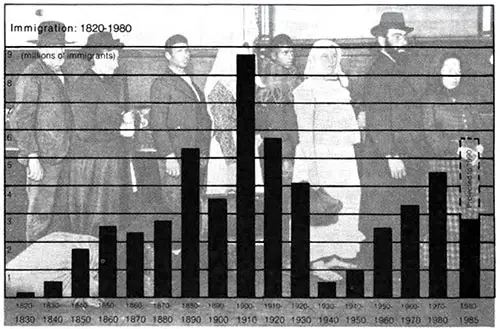Ellis Island Immigration Experience: A Historical Gateway for Millions of Immigrants
📌 Explore the profound impact of Ellis Island on U.S. immigration history through archival images, personal accounts, and detailed articles. Learn about the immigrant experience, health screenings, legal processes, and humanitarian efforts that shaped America’s cultural landscape.
Ellis Island Immigration Experience
Relevance to Immigration Studies for Teachers, Students, Genealogists, Historians, and Others
The Ellis Island Immigration Experience page provides a comprehensive and detailed overview of the significant historical, social, and personal narratives tied to Ellis Island, the most iconic entry point for immigrants to the United States from 1892 to 1954.
This resource is invaluable for teachers and students studying U.S. history, immigration policies, sociology, and public health.
For genealogists, the page offers crucial insights into the procedural challenges immigrants faced at Ellis Island, aiding in tracing the journeys of their ancestors.
Historians can delve into the socio-political implications of immigration during this era, while anyone researching immigration studies will benefit from the rich historical documentation and human stories provided.
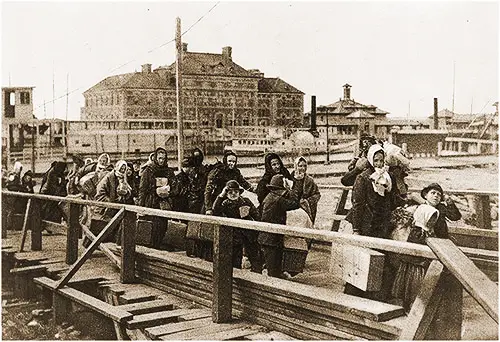
Tender Brings New Immigrants to Landing at Ellis Island. Emigrants coming up the board-walk from the barge, which has taken them off the steamship company's docks, and transported them to Ellis Island. The big building in the background is the new hospital just opened. The ferry-boat seen in the middle of the picture, runs from New York to Ellis Island. Quarantine Sketches, The Maltine Company, 1902 [1]. Library of Congress # 97501086. | GGA Image ID # 148396ba43
Immigrants on inbound ships that arrived in New York were anchored off the Narrows. Inspectors onboard processed first and second-class passengers, and those who passed inspection went on to dock at the piers in Manhattan. Ferries then took steerage passengers to Ellis Island for processing (along with first and second-class passengers who failed inspection). The average immigrant spent three to five hours on Ellis Island.
Important Dates in Ellis Island History
- 11 April 1890: Congress appropriates $75,000 to build an immigration station at Ellis Island.
- 1 January 1892: The immigration station at Ellis Island officially opens.
- 14-15 June, 1897: Fire destroys Ellis Island Buildings, including records of immigrants dating back to 1840. All personds were safely evacuated.
- 17 December 1900: The new and currently standing main building opens at a cost of $1.5 million.
- 1907: Ellis Island has peak number of immigrants arrive (Approximately 1.25 million).
- 1917-1919: Ellis Island serves as a detention center for enemy aliens, a way station for US Navy personnel, and as a hospital for the US Army.
- 1919-1954: Serves as a deportation center in addition to it core purpose as an immigration station.
- 1920: After WWI, Ellis Island Reopened processing 225,206 immigrants.
- 1924: Mass migration ended. Immigrants are now inspected in their countries of origin.
- 1939-1949: Portion of Ellis Island was used as a Coast Guard Station.
- 1941-1954: Portion of Ellis Island served as a detention center for enemy aliens.
- 29 November 1954: Norwegian Merchant Seaman Arne Peterssen, the last immigrant is processed at Ellis Island.
Ellis Island Archival Collection
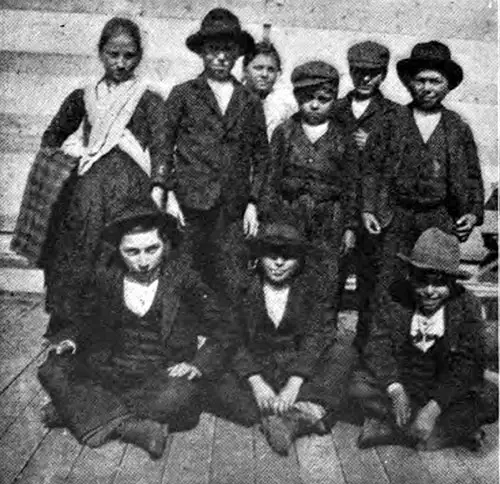
Ellis Island: The Gateway to America – Capturing the Immigrant Experience Through Photographs
Ellis Island served as the main gateway to America for millions of immigrants between 1892 and 1954. The photographs and ephemera presented in this collection vividly capture the immigrant experience during this transformative period of U.S. history. For teachers, students, genealogists, historians, and immigration researchers, these images offer invaluable insight into the conditions, emotions, and challenges faced by the millions who passed through Ellis Island in their pursuit of the American Dream. The photographs from Ellis Island serve as both historical documentation and personal stories, making them essential for anyone studying the history of immigration, cultural integration, and the formation of modern American society.
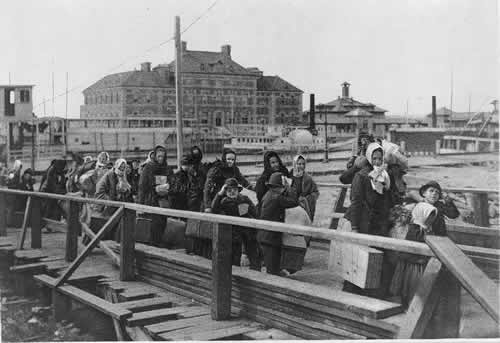
Ellis Island: A Day in the Life of Immigrants, 1895 - Perspectives on the Journey to America
This article from 1895 provides a vivid, personalized account of Ellis Island, from the perspective of a British observer during the height of European immigration to the United States. Its relevance to teachers, students, genealogists, historians, and anyone studying immigration history lies in its rich narrative style and the historical insights it offers into the conditions and challenges faced by immigrants arriving at this iconic entry point. The article highlights not just the procedural aspects of immigration, but also the human side of the immigrant experience, making it a valuable resource for those examining the immigrant journey and its impact on America.
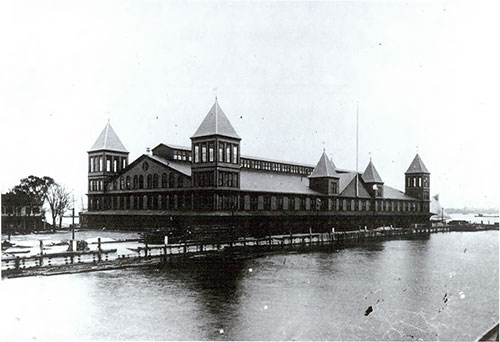
Ellis Island: The Journey and Struggles of Immigrants in 1896
This article, originally published in 1896, offers a detailed narrative of the immigrant experience at Ellis Island, specifically focusing on the challenges, emotions, and bureaucratic procedures involved. It is particularly relevant for teachers, students, genealogists, historians, and immigration researchers. It provides a comprehensive look at the immigration process of the time, and the human stories behind those statistics, offering rich content for examining the broader historical context of immigration to the United States at the turn of the 20th century. Through its focus on the varied immigrant populations and the systems designed to manage them, the article serves as a valuable resource for understanding the emotional and logistical complexities of immigration during this period.
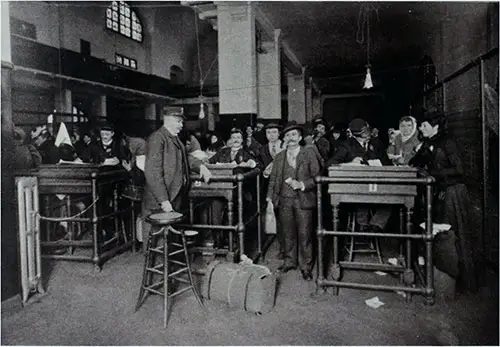
The Immigration Question: A Detailed Study of U.S. Immigration Policies at Ellis Island (1897)
Published in 1897, The Immigration Question by Joseph H. Senner provides an in-depth exploration of the immigration challenges faced by the United States during the late 19th century. It addresses economic, social, and political concerns surrounding the immigration process, particularly at Ellis Island. This article is of immense value to teachers, students, genealogists, historians, and anyone interested in understanding the historical context of immigration to America. The article provides key insights into immigration laws, the processes at Ellis Island, and public attitudes toward immigration at the time.
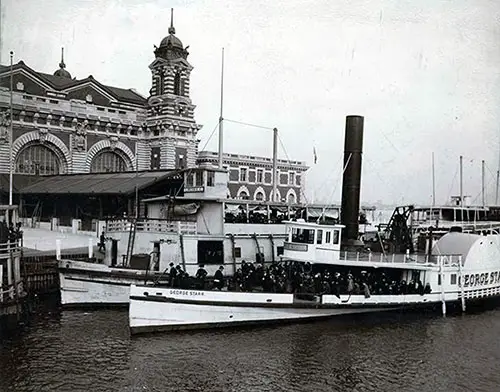
The Journey Begins: Immigrants Arriving at Ellis Island (1897)
Published in 1897, The Landing of the Emigrants provides a detailed snapshot of the immigration process at Ellis Island during a pivotal period in American history. As the primary entry point for millions of immigrants, Ellis Island symbolizes the hope and hardship experienced by newcomers to America. This article is of great significance to teachers, students, genealogists, and historians interested in immigration, social history, and the development of immigration laws in the United States.
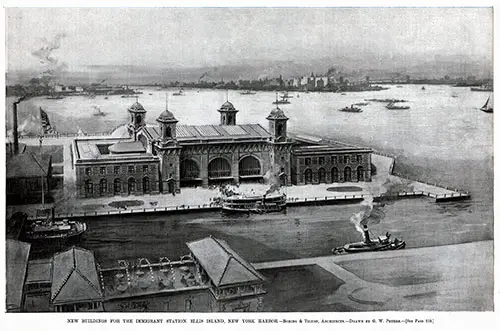
The Threshold of America: The Transformation of Ellis Island in 1898
"The Threshold of America" from 1898 provides a compelling historical narrative of the new immigration facilities on Ellis Island, one of the most significant entry points for immigrants to the United States. With its in-depth analysis of the architectural improvements and the evolution of the immigration process, this article is a key resource for teachers, students, genealogists, historians, and anyone interested in immigration history, architecture, and the development of the U.S. immigration system.
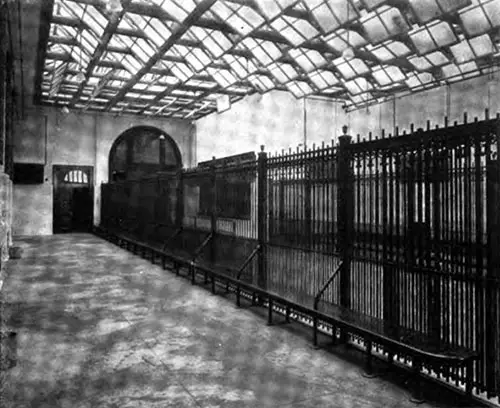
The Arrival of the Immigrant: Inside the Barge Office at Ellis Island in 1898
“The Arrival of the Immigrant” from 1898 offers a vivid, detailed portrayal of the immigration experience at the Barge Office in New York, just before immigrants were processed and either admitted or detained. This article serves as a valuable resource for teachers, students, genealogists, historians, and anyone interested in immigration history, as it explores the emotions, processes, and challenges faced by immigrants arriving in the U.S. during this pivotal time in American history. By capturing both the physical conditions of the arrival process and the cultural nuances of the immigrants, it provides a rich historical context for those researching the experiences of immigrants in the late 19th century.
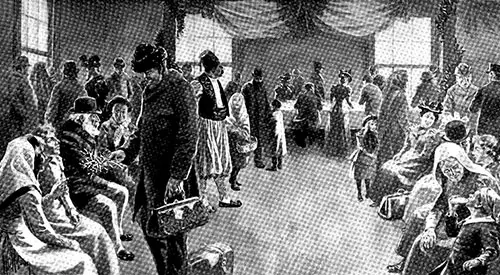
Homeless Immigrants Christmas at the Barge Office: A Moment of Cheer Amidst Hardship (1898)
"Homeless Immigrants Christmas at the Barge Office" from December 1898 provides a heartwarming yet sobering look at the immigrant experience during Christmas at the Barge Office, New York's entry point for immigrants during the late 19th century. This piece is valuable for teachers, students, genealogists, and historians as it offers insight into both the human and systematic aspects of immigration processing at the time. The article reflects on how America, despite its struggles and harsh immigration processes, welcomed newcomers during the festive season with a small semblance of warmth and community. It underscores the challenges faced by immigrants and the institutional support that helped alleviate their plight, especially during the holidays.
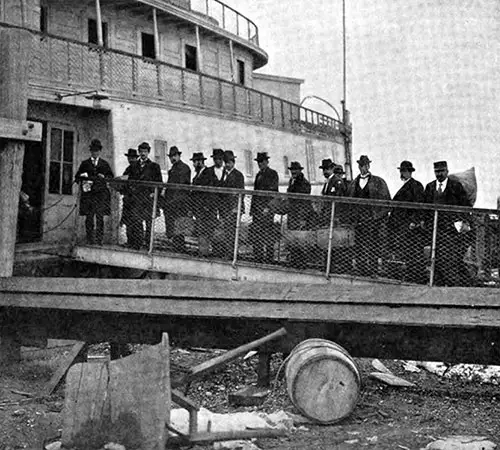
Ellis Island and the Immigrant Journey: Inside the Barge Office and the Board of Inquiry (1899)
"Ellis Island: The Great Gateway to America - 1899" is a detailed, evocative article that sheds light on the immigrant experience at one of America’s most iconic landmarks. It captures the systematic process of immigration, particularly during the post-fire reconstruction period when immigrants were temporarily processed at the Barge Office in New York Harbor. This article serves as an essential piece for teachers, students, genealogists, and historians interested in understanding the complexity of early American immigration. It provides a snapshot of the rigorous processes, social challenges, and human stories that characterized the journey for many immigrants entering the United States.
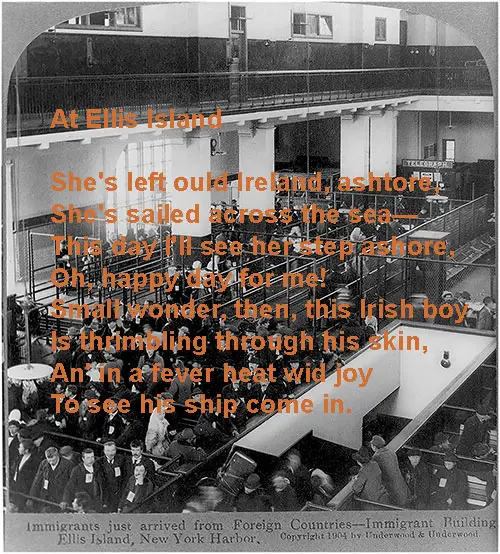
At Ellis Island: A Poignant Poem of Reunion and Hope (1900)
The poem "At Ellis Island - A Poem for a Loved One" offers a poignant, lyrical reflection on the immigrant experience, specifically through the eyes of an Irish immigrant waiting for his wife to arrive at Ellis Island. It encapsulates the joy and anticipation of reunion after long separation and the emotional weight carried by many immigrants who journeyed to America in search of better opportunities. This poem resonates deeply with the themes of immigration, family separation, and the hope that drove many to leave their homelands for the uncertain shores of America. It provides a unique perspective on the human side of immigration that is invaluable for teachers, students, genealogists, and historians looking to better understand the emotional struggles faced by immigrants in the late 19th and early 20th centuries.
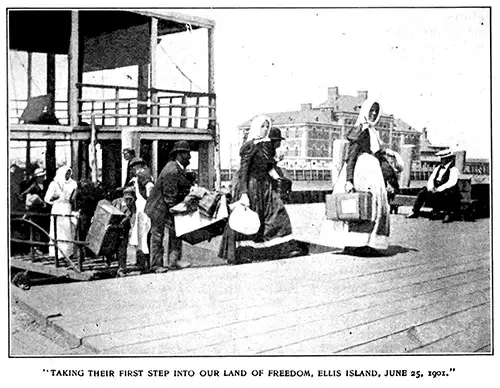
A Morning's Scenes at Ellis Island - 1901: The Immigrant Experience and Challenges
The article "A Morning's Scenes at Ellis Island", published in 1901, offers a snapshot of the immigrant experience at Ellis Island during a significant period in U.S. history. It highlights the emotions, challenges, and realities that faced immigrants as they arrived in the United States, with a particular focus on the process of examination and detention. The article's significance lies in its exploration of the human side of immigration, portraying the physical and emotional toll that the journey to America had on immigrants. For teachers, students, genealogists, historians, and anyone studying immigration, this article provides a rich historical context, blending real-life experiences with the larger societal and political forces that shaped immigration policy at the time.
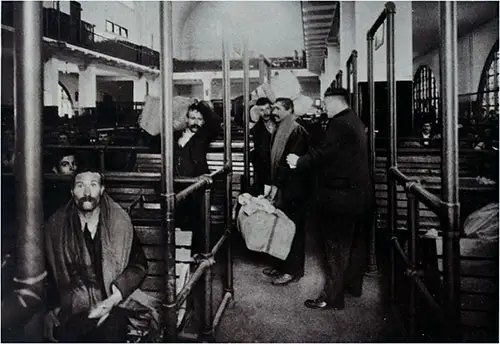
Ellis Island Quarantine Sketches - 1902: A Visual History of Immigration Health and Screening
The 1902 Ellis Island Quarantine Sketches pamphlet, produced by the Maltine Company, offers an in-depth visual and descriptive documentation of the immigration process at Ellis Island during the early 20th century, particularly focusing on the quarantine measures in place to ensure the health and safety of incoming immigrants. This resource is of immense historical value to teachers, students, genealogists, historians, and anyone researching immigration history or the health policies of the time.
By documenting the procedures in place to screen immigrants for diseases and their progress through Ellis Island's facilities, this pamphlet captures a crucial moment in the immigration system, providing both a historical account and a human perspective on the immigrant experience. Its value lies not only in its historical content but also in its vivid imagery, which reflects the medical and bureaucratic systems that immigrants encountered upon arrival in the U.S.
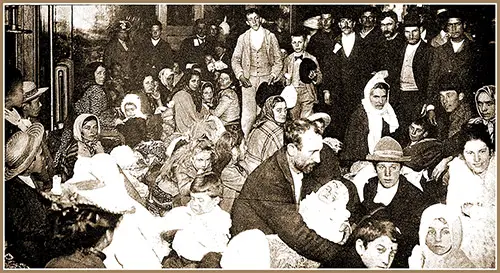
Enormous Flood of Immigrants from Europe: The Struggles and Exploitation at Ellis Island in 1902
The article Enormous Flood of Immigrants from Europe - 1902, published in Leslie's Weekly, provides an in-depth account of the tremendous wave of European immigrants arriving at Ellis Island in the early 20th century. With immigration figures skyrocketing, especially during the year 1902, this article offers valuable insight into the human struggles and bureaucratic hurdles immigrants faced upon their arrival in the United States. The article is relevant to teachers, students, genealogists, and historians, as it sheds light on the socioeconomic challenges, public health concerns, and the emotional toll of the immigration experience during a time of massive global migration.
The account captures the sheer scale of immigration, highlighting the immense number of immigrants flooding Ellis Island and the difficult journey many endured, both during their travels and upon their arrival. This article is vital for understanding the historical context of immigration policy and the personal hardships experienced by many immigrants, especially the poor and vulnerable, during the turn of the century.
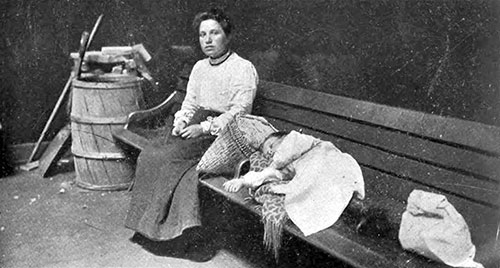
Americans In The Raw: The Struggles of Immigrants at Ellis Island (1902)
The article Americans in the Raw - Immigrants at Ellis Island from The World's Work offers a comprehensive and vivid portrayal of the immigrant experience at Ellis Island in the early 1900s, highlighting the intense influx of immigrants, their struggles, and their initial steps in America. Written by Edward Lowry, the piece serves as both a historical snapshot of immigration practices and a deeply human exploration of the immigrant journey. With photographs by Arthur Hewitt, this article provides rich context for teachers, students, genealogists, historians, and anyone interested in the immigrant experience, making it a valuable resource for understanding how this wave of immigrants shaped both their lives and America's development.
The article is especially relevant as it describes the immigrant inspection process, detailing the personal possessions, money, and personal stories of those who arrived. It also delves into the challenges faced by immigrants—from harsh working conditions to the exploitation they encountered in the streets of New York. For genealogists, it offers an excellent snapshot of the diverse origins of immigrants and the procedures they underwent, helping to build a clearer understanding of ancestral immigration during this period.
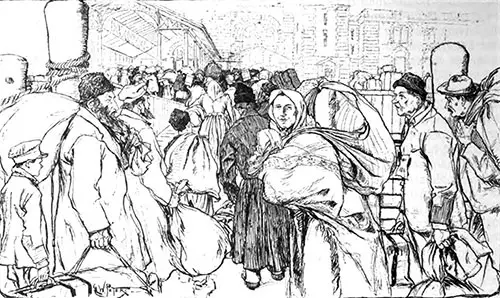
In The Gateway of Nations: The Immigrant Experience at Ellis Island (1903)
The article In The Gateway of Nations by Jacob A. Riis, accompanied by illustrations from G. W. Peters, paints a vivid picture of the immigrant experience at Ellis Island in the early 20th century. Published in The Century Magazine in 1903, this piece delves into the vast waves of immigrants arriving at the United States during a time when immigration was at its peak. The article serves as a powerful tool for teachers, students, genealogists, historians, and anyone interested in understanding the human aspect of immigration during this period.
This piece is particularly relevant to immigration studies, as it captures the social, cultural, and economic dynamics that shaped the experience of millions of immigrants who passed through Ellis Island. For genealogists, it provides insight into the lives of ancestors who may have arrived through Ellis Island, as well as the struggles they endured in their quest for a new life. Historians will find the article valuable in understanding how immigrants were perceived and treated by both society and the government at the time.
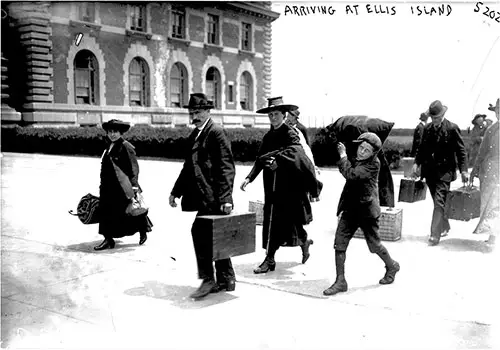
The Great Migration: Ellis Island and the Immigrant Experience in 1903
The Great Migration article, published in October 1903 in The Home Missionary, offers a detailed account of the immigrant experience at the Port of New York, specifically focusing on Ellis Island, during the early 20th century. Written by Rev. Paul Sommerlatte and Margaret Gold Batchelder, this article presents a first-hand look at the immigration process, the challenges faced by new arrivals, and the immigrant impact on America. It is a rich historical source that provides teachers, students, genealogists, and historians with valuable insights into the conditions, customs, and systems surrounding immigration at the time.
This account is particularly valuable for understanding the complexity of the immigration system, the prejudices and barriers that immigrants faced, and their resilience. It is essential reading for those interested in early 20th-century immigration, the political climate of the time, and the evolution of American identity shaped by waves of immigrants from Europe, Asia, and other parts of the world. Genealogists will find this article particularly insightful for understanding the bureaucratic processes their ancestors likely encountered when arriving at Ellis Island.
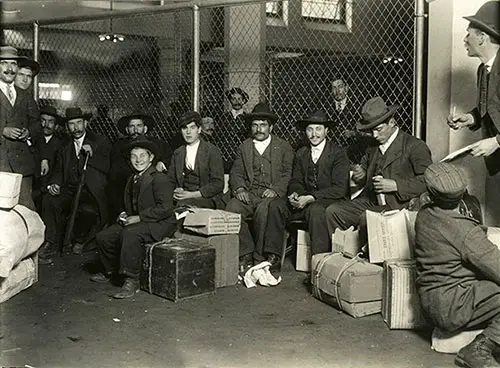
The Immigration Problem: Europe's 1903 Flood and its Impact on America
The Immigration Problem - Flood From Europe 1903 presents a comprehensive analysis of the record-breaking immigration surge to the United States in 1903, reflecting on the challenges, societal impacts, and political implications of the increasing number of immigrants arriving at the nation's shores. This article, deeply rooted in the immigration concerns of the early 20th century, offers invaluable insight into the periodic waves of immigration that shaped American society, particularly as it pertains to economic, social, and political pressures.
For teachers, students, historians, and genealogists, this piece is a critical historical document that delves into both the immigration policies and the experiences of newcomers during a time when the U.S. faced a growing influx of immigrants from Southern and Eastern Europe, marking a significant shift in the composition of immigrants arriving. The focus on assimilation challenges and the economic impact of immigration makes this article essential for understanding the complexity of the nation's early immigration system and its enduring legacy.
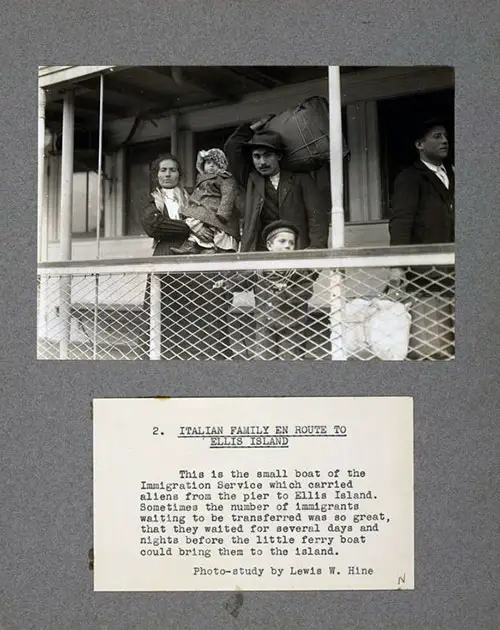
Solving the Immigration Problem: The Role of Italian Immigrant Societies in 1904
Solving The Immigration Problem (1904) provides an in-depth exploration of the issues surrounding immigration in the early 20th century, specifically focusing on the challenges faced by Italian immigrants in the United States. The article outlines not only the difficulties of assimilation but also the positive actions taken by organizations, particularly the Society for the Protection of Italian Immigrants, to address these issues.
This article is invaluable for teachers, students, genealogists, historians, and anyone studying the social and political landscape of early U.S. immigration. It offers critical insights into how immigrant societies helped bridge the gap between newcomers and the broader American society, advocating for practical solutions rather than fear or prejudice.
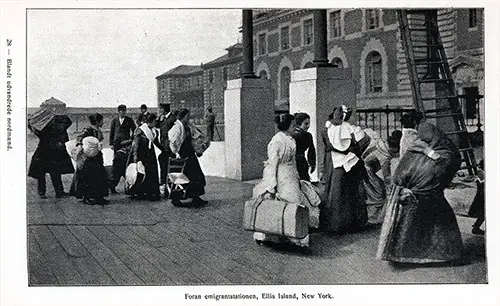
Photographs of Ellis Island Immigrants – A Glimpse into Early 20th Century Immigration (1904/1905)
The Photographs of Ellis Island Immigrants (1904/1905) offers a visual documentation of the immigrant experience at Ellis Island, the primary entry point to the United States in the early 20th century. Published in the Norwegian book Blandt Udvandrede Nordmænd ("Among Expatriate Norwegians"), this collection provides insightful imagery of immigrants, particularly those from Norway, arriving at Ellis Island. These photographs serve as both a historical record and a humanizing portrayal of immigration, making it an essential resource for teachers, students, genealogists, and historians exploring the broader narratives of immigration and assimilation during this pivotal period in U.S. history.
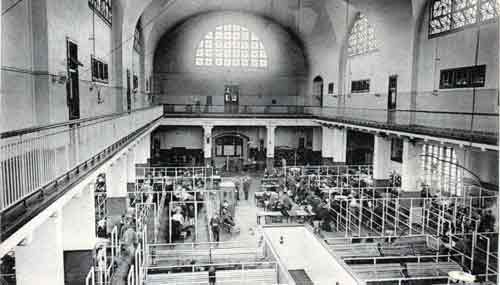
The article How Immigrants Are Inspected at Ellis Island (1905) offers a detailed exploration of the immigration process during the early 20th century, focusing on the medical and legal inspections immigrants underwent upon arrival at the iconic Ellis Island. This article is highly relevant for teachers, students, genealogists, historians, and immigration researchers, providing a historical snapshot of the rigorous and often complex procedures that immigrants faced before being granted entry into the United States. The text provides insights into both the logistical operations at Ellis Island and the human side of the immigration experience, giving depth to the historical understanding of U.S. immigration policies.
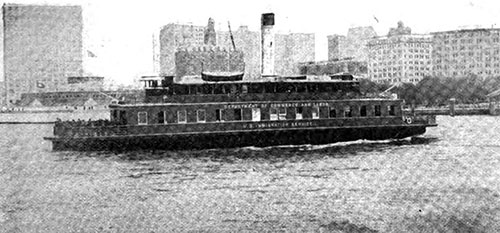
Efficient Systems of Immigrant Handling at Ellis Island: A Business Perspective (1905)
The article How Immigrants Are Handled – A Business Perspective (1905) offers a fascinating examination of the immigration process at Ellis Island, with a particular focus on the efficiency and logistical aspects of the U.S. immigration system. Through a business lens, the article explores the methods employed by the U.S. government to manage the arrival of thousands of immigrants daily, focusing on their distribution across the country and the broader economic implications of immigration.
This content is highly relevant for teachers, students, genealogists, historians, and immigration researchers, offering a pragmatic view of the immigration process that sheds light on how early 20th-century systems impacted immigration policies and practices.

Flood Tide of Immigration: A Record Surge at Ellis Island in 1906
The brief article Flood Tide of Immigration (1906) offers a detailed account of the massive surge in immigration to the United States at the turn of the 20th century, specifically on April 16, 1906. It discusses the logistical challenges faced by immigration officials at Ellis Island as they struggled to manage the arrival of tens of thousands of immigrants.
This historical account is highly relevant to teachers, students, genealogists, historians, and immigration researchers, as it provides insight into the immigration process, the immigration system of the time, and the political and social dynamics surrounding large-scale migration to the U.S.
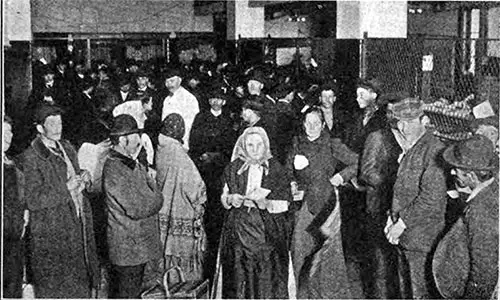
The Gateway to America: Immigration at Ellis Island in 1906
The Gateway to America for European Immigrants (1906) offers a detailed look at the process and challenges of handling the massive influx of immigrants arriving at Ellis Island, New York, in the early 20th century. The article explores the immigration system, the physical and health inspections immigrants underwent, and the logistical challenges of processing millions of immigrants annually.
This account is especially relevant for teachers, students, genealogists, historians, and anyone studying the history of immigration to the U.S., as it highlights the humanitarian and organizational aspects of the immigration process that shaped American society.
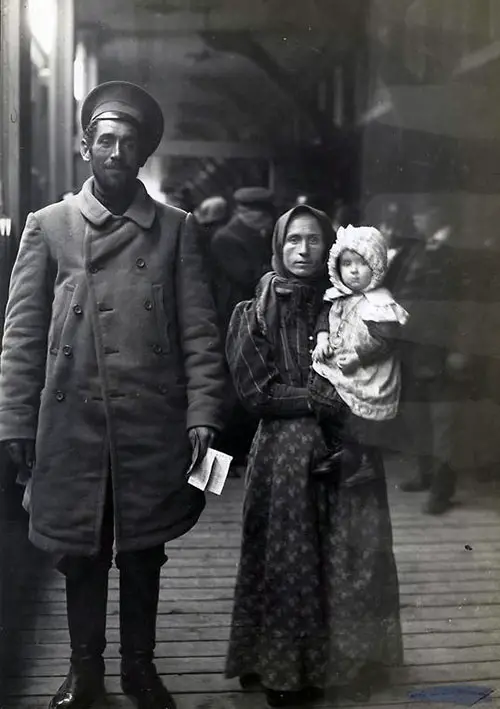
The Child Immigrant Experience at Ellis Island - 1906: A Glimpse into America's Immigration Crisis
The Child Immigrant at Ellis Island (1906) provides a thought-provoking examination of the unique experiences and challenges faced by immigrant children arriving at Ellis Island during a time of mass immigration to the United States. Through vivid descriptions, personalized anecdotes, and ethnological analysis, the article highlights the diverse backgrounds and cultural identities of these young newcomers and their role in shaping the American workforce and society.
This article is an excellent resource for teachers, students, genealogists, historians, and anyone with an interest in immigration history, as it explores the human impact of immigration, particularly on children, and presents a nuanced view of the challenges immigrants faced in assimilating to American life. It also gives insights into the ethnic diversity and sociocultural transformation of early 20th-century America.
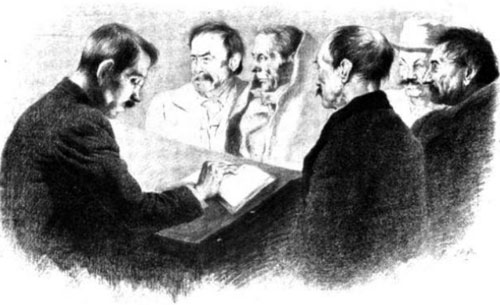
The Men Who Are To Vote: A Journey Through Ellis Island and the American Dream (1906)
Ernest Poole’s article, The Men Who Are To Vote, written in 1906, provides a vivid portrayal of the lives of immigrants entering America through Ellis Island at the turn of the 20th century. This piece is an invaluable resource for teachers, students, genealogists, historians, and anyone studying the history of immigration and its societal impacts. Poole captures the emotions, challenges, and aspirations of the immigrants, particularly focusing on laborers who were entering the U.S. with hopes of a better life and, in some cases, future political participation. The piece also touches on the complexity of assimilation, as immigrants navigate the immigration process and their evolving role in American society.
This article offers a humanistic view of immigration, contrasting the personal stories of immigrants with the systemic and often dehumanizing processes at Ellis Island. It's a great resource for understanding both the hardships and the hope of the immigrant experience, providing insight into the historical context of political empowerment and the labor forces that would shape America.
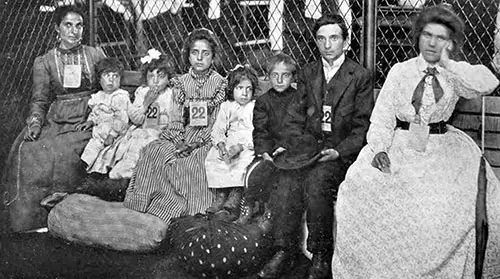
Helping Irish Girls at Ellis Island: A Mission of Care and Protection for Immigrant Women in 1906
Helping Irish Girls at Ellis Island from 1906 offers a detailed account of the important work carried out by the Mission of Our Lady of the Rosary to protect Irish immigrant girls arriving at Ellis Island. This article is a crucial resource for teachers, students, historians, genealogists, and anyone interested in the immigrant experience, particularly the challenges faced by young women who arrived alone in America during the early 20th century. It highlights not only the humanitarian efforts of the Mission but also the broader social and cultural context in which Irish immigrants, particularly women, navigated their new lives in the United States.
The article focuses on the vital role that religious and philanthropic organizations played in assisting and protecting vulnerable immigrants, providing safe spaces, employment assistance, and spiritual guidance during a period of intense immigration to America. This account serves as a historical reflection on the evolving role of community organizations in assisting immigrants, especially women, and their struggles for safety, dignity, and economic opportunity.
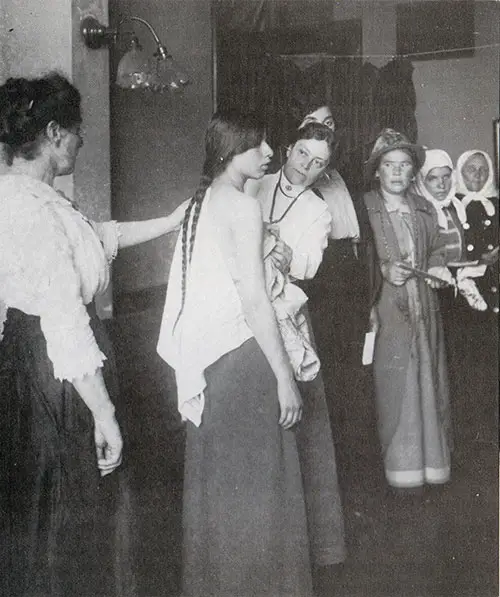
The Inspection and Registration of Immigrants: The Ellis Island Process of 1906
The article "The Inspection and Registration of Immigrants" from 1906 provides an in-depth and comprehensive look into the immigration process at Ellis Island. It details the systematic and rigorous inspection procedures that immigrants underwent upon their arrival in the United States, highlighting the crucial role of the Immigration Bureau, the varied steps of inspection, and the challenges posed by such a large influx of newcomers. The piece is highly relevant for teachers, students, genealogists, historians, and immigration scholars, offering insights into the methods of processing immigrants at Ellis Island during the early 20th century.
The article’s value lies in its practical descriptions of the examination process, the immigrant experience, and the types of scrutiny that immigrants faced. It also sheds light on the human side of immigration — from the physical inspections to the bureaucratic procedures immigrants navigated in hopes of starting a new life in America. Historians and genealogists will find this article valuable in understanding the conditions of their immigrant ancestors, while teachers can use it as a resource to teach about early 20th-century immigration and the policies that shaped the American workforce.

An Interview with Commissioner Robert Watchorn on U.S. Immigration (1906)
The article "An Interview with the Commissioner of Immigration - 1906" provides an insightful conversation with Robert Watchorn, the Commissioner of Immigration at Ellis Island. Through this interview, Watchorn offers his perspective on immigration trends, the processes at Ellis Island, and the economic implications of immigration.
The article is valuable for teachers, students, genealogists, historians, and anyone researching early 20th-century immigration. Watchorn’s insights help contextualize the immense challenges and benefits associated with the massive waves of immigrants arriving at Ellis Island during the early 1900s.
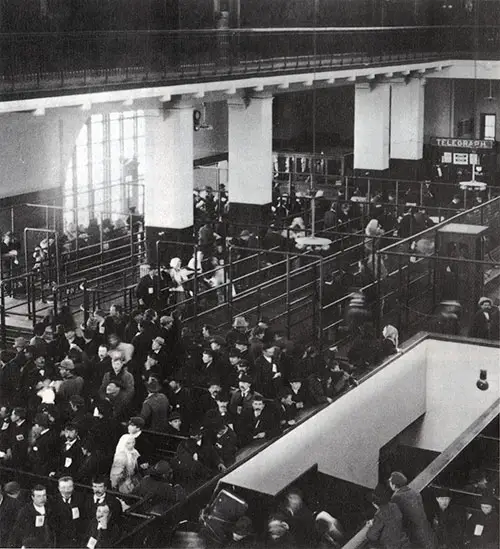
Ellis Island: The Island of Disenchantment - Stories of Immigration Struggles (1907)
Ellis Island: The Island of Disenchantment is a heartfelt narrative that brings to life the struggles, disappointments, and hardships faced by immigrants passing through Ellis Island at the turn of the twentieth century. Through a series of personal stories, the author paints a vivid picture of the emotional toll of the immigration process, where hope and disenchantment coexist. This article is especially valuable for teachers, students, genealogists, and historians, providing personalized accounts that humanize the immigrant experience, making it an invaluable resource for anyone studying immigration history or genealogy.
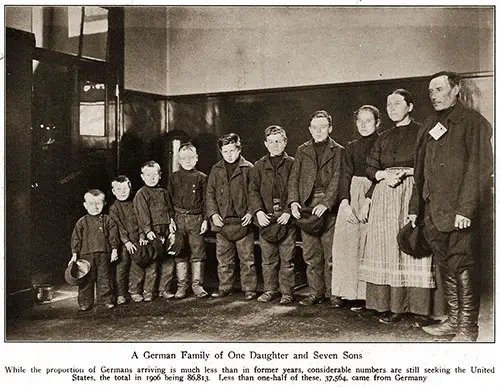
A Look at the People Coming Through Ellis Island: Portraits of Early 20th Century Immigration (1907)
This article, A Look At The People Coming Through Ellis Island, from National Geographic Magazine (May 1907), provides an insightful snapshot into the massive wave of immigration to the United States during the early 20th century. The article highlights the diverse origins of immigrants, their financial conditions, and physical characteristics, offering valuable context for teachers, students, genealogists, historians, and anyone interested in understanding the social, cultural, and economic effects of immigration.
The article not only offers vivid imagery but also contains important statistics that shed light on the scope of immigration at the time. It serves as a primary source for understanding the ethnic makeup and the challenges immigrants faced, providing essential information for immigration studies and genealogy research.
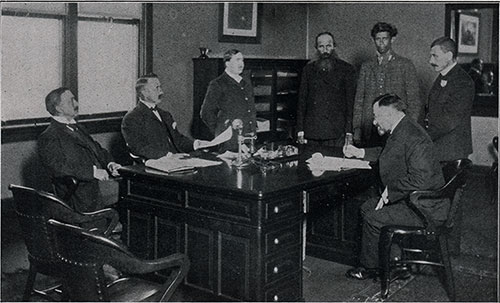
Curbing A Human Flood of Immigration: The 1907 Immigration Law and Its Impact
The article, Curbing A Human Flood of Immigration - A New Law Takes Effect, provides an insightful perspective on the immigration policies of the early 20th century and the introduction of the new immigration law in 1907. It outlines the significant challenges posed by the rapid influx of immigrants into the United States and the measures taken to regulate and distribute immigrants more evenly across the country.
For historians, genealogists, students, and educators, this article is a valuable resource for understanding the socio-political climate surrounding immigration during this period and the government’s efforts to address issues such as overcrowding, poor living conditions, and the misdistribution of immigrant populations. It also provides a deep dive into the cultural diversity of immigrants and the geographic impact on the U.S. population.
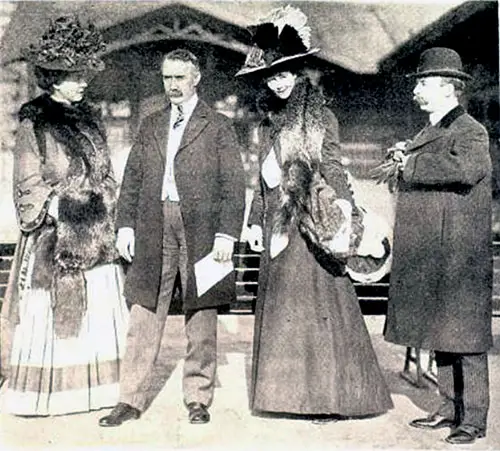
Duchess Samples Ellis Island Pie: A Royal Visit and Its Impact on Immigration Perceptions (1907)
The article, Duchess Samples Ellis Island Pie - 1907, offers a fascinating glimpse into a historical event where the Duchess of Marlborough, accompanied by her guests, visited Ellis Island and experienced first-hand the operations of the immigrant processing system. Beyond the lighthearted moments, such as the Duchess sampling pie, the visit underscores the human element of immigration and the work of those involved in aiding newcomers to the United States during a time of mass migration.
For teachers, students, genealogists, and historians, this article provides a cultural and historical snapshot of immigration practices in the early 20th century, the societal attitudes toward immigrants, and the ways the elite class engaged with the immigrant experience. It serves as an interesting study of the intersection between immigration policy, government operations, and public perception in shaping American society.
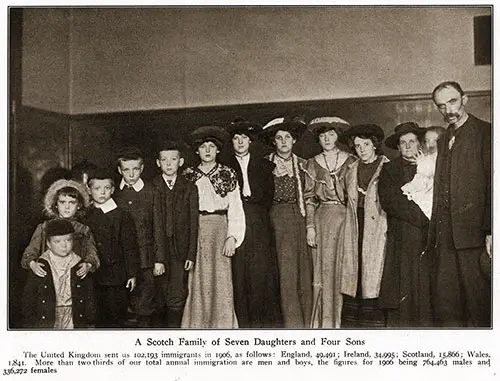
How Uncle Sam Welcomes Immigrants: A Detailed Look at Ellis Island in 1907
The article "How Uncle Sam Welcomes the Stranger at His Gates - 1907" provides a detailed look at the processes and human experiences associated with immigration to the United States through Ellis Island, one of the most significant immigration stations in history. Through the eyes of the immigrants themselves and the efforts of immigration officials, it illustrates both the humanitarian aspects and the bureaucratic challenges of processing millions of newcomers during the height of the immigration wave in the early 1900s.
This article is especially relevant for teachers, students, genealogists, and historians, as it gives an intimate view of the immigrant experience, the inner workings of immigration procedures, and the role of government in managing mass migration. The descriptive details, paired with historical insights, allow readers to explore both the individual stories of immigrants and the larger patterns of migration to the U.S.
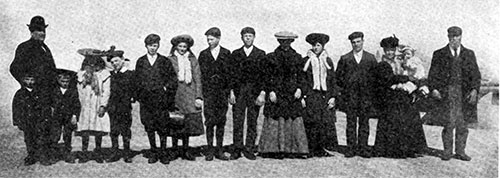
Face to Face – A College Group Observes the Immigration Process at Ellis Island (1908)
The article "Face to Face – Students Observe the Immigration Process at Ellis Island" offers a unique, human-centered account of the immigration process in the early 20th century, using the experience of a group of college students as a lens to explore the often heart-wrenching decisions made at Ellis Island. By following the personal story of an elderly Italian immigrant and his search for his son, the narrative captures both the bureaucratic side of immigration and the deeply emotional journeys that many immigrants undertook.
This article is highly relevant to teachers, students, genealogists, and historians, as it provides rich context for studying immigration laws, family reunifications, and the personal stories of immigrants arriving in the United States. The emotional intensity of the narrative is impactful for anyone seeking to understand the human side of historical immigration policies, while also offering valuable insights into the detailed workings of Ellis Island during its peak years.
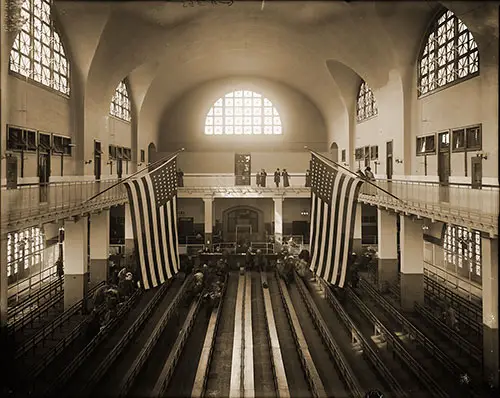
The New Ellis Island – Major Improvements in Immigrant Treatment and Facilities (1908)
The article "The New Ellis Island – Improvements for the Arriving Immigrants" provides an insightful look into the ongoing changes and upgrades at Ellis Island in the early 20th century, with a focus on improving conditions for the immigrants arriving in the United States. Written in 1908, it reveals the challenges that immigrants faced and the steps taken to provide better treatment, accommodation, and care.
This article is of significant value to teachers, students, genealogists, and historians, offering a historical perspective on Ellis Island’s role in immigration and its evolution over time. The detailed description of the physical and procedural improvements makes it an excellent resource for those studying immigration history, public health, and social reform.
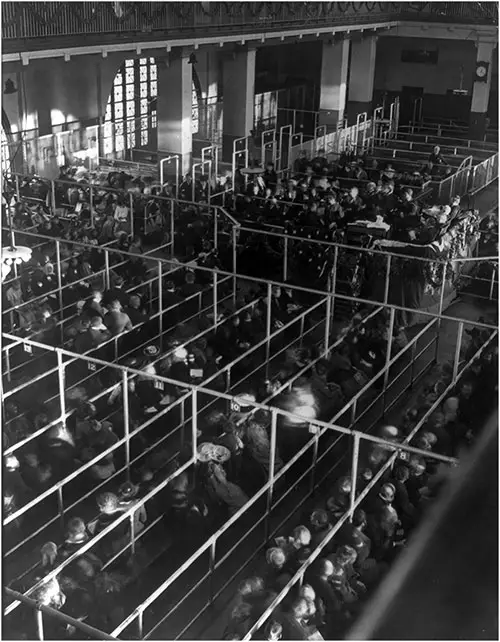
Christmas at Ellis Island: A Glimpse into Immigrant Life in 1907
This article, originally published in The Home Missionary in February 1908, offers a heartwarming yet poignant depiction of Christmas at Ellis Island, where over 1,600 immigrants spent the holiday away from their families and homelands. Through this narrative, the piece highlights the humanity of those arriving in the United States at a time of social and political change, offering a unique view of both the hardship and the hope experienced by immigrants. It is a valuable resource for teachers, students, genealogists, and historians interested in the immigrant experience, especially during the early 20th century.

Ellis Island Through the Lens: A Photographer’s Account of Immigrant Life (1908)
In the article "Ellis Island As Seen By The Camera Man", originally published in The World Today in April 1908, Julian A. Dimock provides a vivid and personal account of the immigrant experience at Ellis Island. Through both his photography and observations, Dimock captures the complex emotions, the human drama, and the bureaucratic procedures that shaped the immigrant journey to the United States.
This article is a valuable resource for educators, students, genealogists, historians, and others interested in the immigration experience, offering unique insights into the early 20th-century policies and practices at one of America’s most iconic immigration centers.
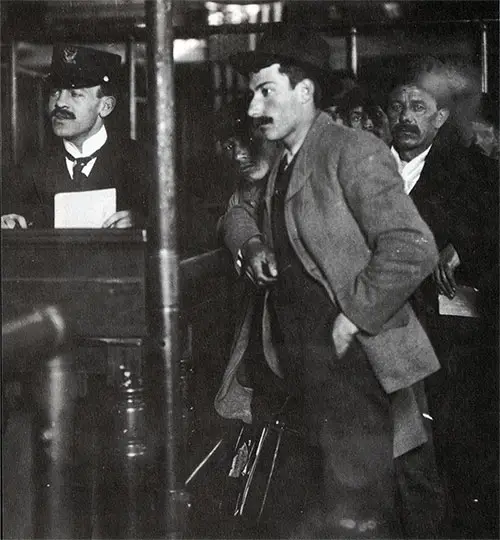
Inside Ellis Island: A Personal Account of the Immigrant Experience (1908)
In "The Immigrant Processing at Ellis Island," Jessie Kemp Hawkins provides a vivid, firsthand account of the grueling and complex process immigrants faced upon arriving in the United States through Ellis Island in the early 20th century.
The article, written in 1908, offers an invaluable perspective on the bureaucratic, medical, and emotional trials of new arrivals at the U.S. immigration hub. It is a significant resource for educators, historians, genealogists, and anyone studying the immigrant experience, providing rich insights into the systems and structures of early American immigration policies.
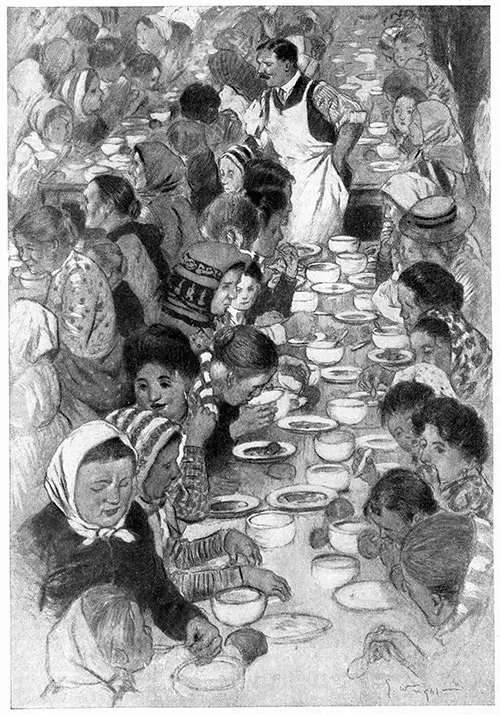
Christmas at Ellis Island: A Reflection on Immigration and Resilience (1908)
Eugene Wood's article, "Christmas at Ellis Island," offers a unique, though critical, perspective on the immigrant experience during the holiday season at one of America's most iconic immigration processing stations.
For educators, students, genealogists, historians, and anyone interested in immigration studies, this piece provides valuable insights into the challenges immigrants faced upon arrival in the United States during the early 1900s.
The narrative highlights the emotional and physical toll of immigration, while juxtaposing the cultural differences and the social structures that were imposed upon these new arrivals.
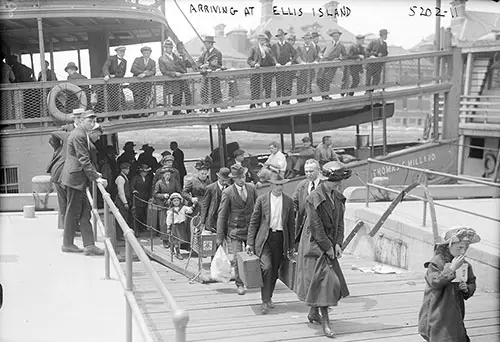
Rene Bache's article "Government To Find Work For All" (1908) provides an insightful look at the federal government’s efforts to address the employment needs of immigrants arriving in the United States at the turn of the 20th century. For teachers, students, genealogists, historians, and anyone with an interest in immigration studies, this piece serves as a valuable historical document illustrating how the U.S. government sought to integrate the millions of immigrants arriving each year while balancing the economic and social needs of both the newcomers and the native-born citizens.
The creation of the Division of Information as a government-sponsored employment agency reveals the early attempts to provide organized assistance for immigrants seeking jobs and economic stability. The federal program’s goal to find work for both foreign-born and native-born Americans and distribute immigrants across the country based on labor demands highlights the changing attitudes towards immigration and labor during this period.
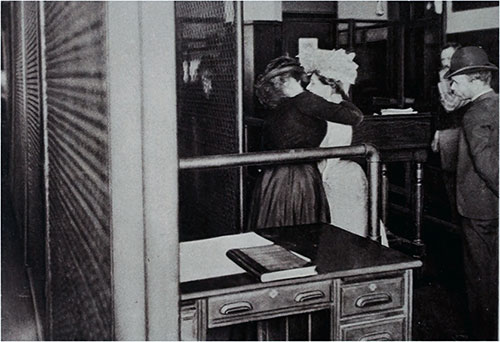
The Loves of Ellis Island: Immigrant Reunions and Hardships at the Gateway to America (1909)
Mabel Potter Daggett’s “The Loves of Ellis Island” (1909) provides a deeply emotional portrayal of the immigrant experience at Ellis Island, emphasizing the human aspects of migration that are often overshadowed by bureaucratic processes. This article holds significant relevance for teachers, students, genealogists, historians, and anyone studying immigration, as it highlights the personal struggles, emotional reunions, and the complexity of identity and belonging experienced by immigrants as they passed through Ellis Island.
For historians and genealogists, this work offers insight into the daily lives of immigrants in the early 20th century. For educators, it provides a vivid narrative that can help students better understand the human side of immigration—the emotional labor of separation, the optimism, and the hardships faced by newcomers. The story of love and separation at Ellis Island is one that transcends historical time and remains highly relevant in today’s global context of migration.
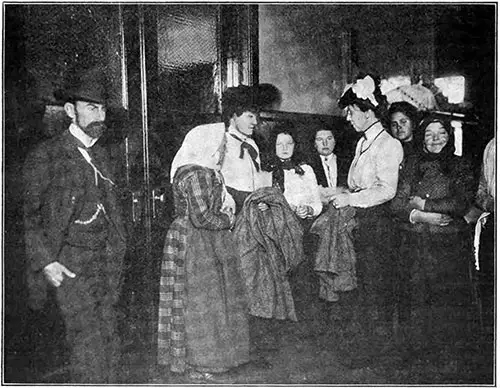
The Mission Work at Ellis Island: Faith, Charity, and Support for Immigrants (1909)
The article “The Mission Work at Ellis Island” (1909) holds significant relevance to immigration studies, offering a unique glimpse into the intersection of faith, charity, and the immigrant experience at Ellis Island during the early 20th century.
For teachers, students, genealogists, historians, and others interested in immigration history, the article illuminates the essential role that religious and charitable organizations played in supporting immigrants who faced uncertainty and hardships at the threshold of America.
It serves as a powerful reminder of how faith-based initiatives, alongside government efforts, provided solace and practical assistance to thousands of newcomers.
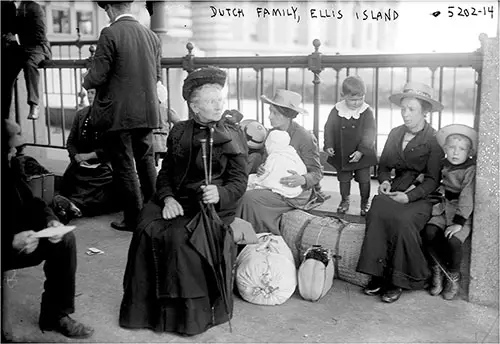
A Mother’s Story of Ellis Island: An Emotional Account of Immigration and Family Separation (1911)
“A Mother’s Story of Ellis Island” (1911) is an insightful narrative that powerfully portrays the emotional and physical challenges immigrants faced when arriving at Ellis Island in the early 20th century. For teachers, students, genealogists, and historians, the article offers an empathetic view of the immigrant experience, particularly the hardships and hope surrounding family separation, quarantine, and the immigrant journey. It provides a poignant lens into the intersection of personal tragedy and cultural exchange, making it an essential read for those studying immigration, social history, or the human aspects of migration.
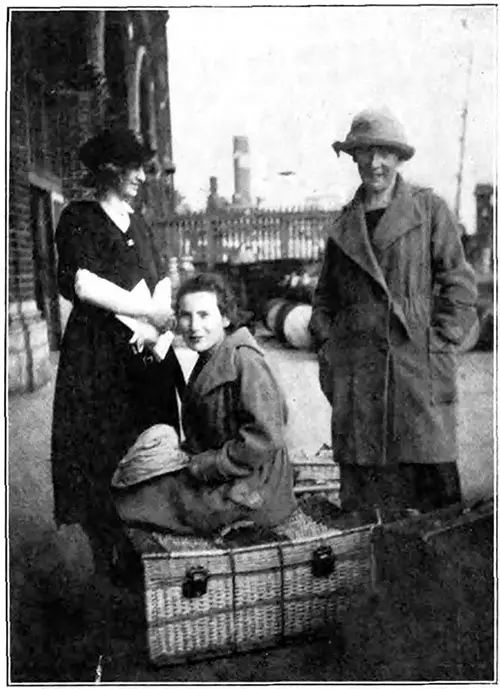
Jewish Women’s Crucial Role in Immigrant Aid at Ellis Island: A 1912 Perspective
“What Jewish Women Are Doing for the Jews at Ellis Island” (1912) offers an insightful account of the proactive efforts made by Jewish women to support newly arrived Jewish immigrants at Ellis Island.
This article is a key resource for educators, students, genealogists, and historians alike, as it not only discusses the pivotal role of Jewish women in immigration assistance but also provides a unique look into the social service work at Ellis Island. The focus on how these women helped immigrants navigate their arrival, legal hurdles, and adjustment to a new life highlights the important contributions of female volunteers in the early 20th century.
This narrative is an essential addition to immigration studies, shedding light on the Jewish community's role in welcoming and integrating fellow Jews into American society during a period of great upheaval and transformation.
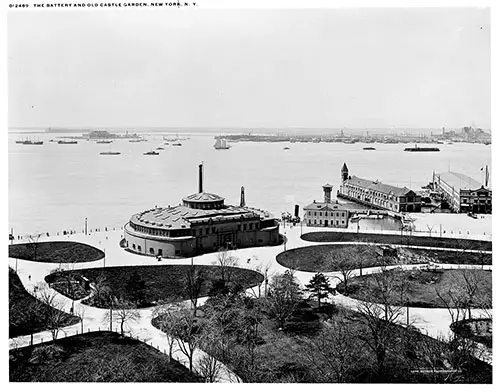
A Place to While Away An Hour – New York's Battery offers a fascinating and scenic look at one of the most historically significant locations in New York City. For immigration studies, this article provides context about the Battery’s dual function as both a point of departure for American customs and a key entry point for immigrants arriving at Ellis Island.
The reference to the Barge Office and Castle Garden highlights the early experiences of immigrants before Ellis Island was established, making it a valuable historical snapshot for educators, students, genealogists, and historians studying the immigrant experience in the United States.
The article captures the essence of Battery Park as a place of transition—a site where millions of immigrants set foot on American soil, making it relevant for those researching the immigrant experience at the turn of the 20th century. It also ties into broader themes of American growth, urban development, and the intersections of history, culture, and immigration.
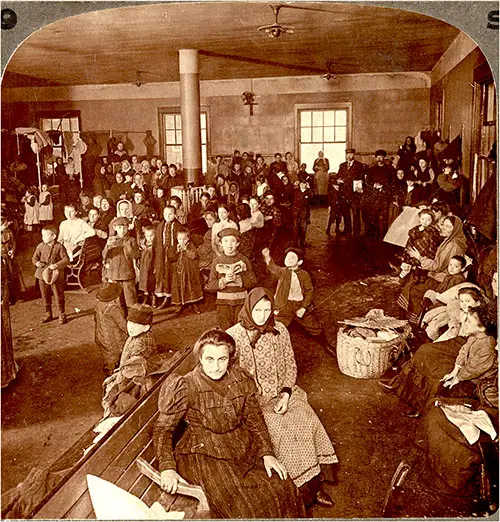
Exploitation and Protection: Immigrants at Ellis Island and the Port of New York (1912)
This article presents an in-depth investigation into the transportation and protection systems set in place for immigrants arriving and departing through the Port of New York, with a focus on the critical role of Ellis Island. It is a valuable resource for educators, students, genealogists, and historians interested in the complexities of the immigrant experience during the early 20th century. The detailed exploration of how immigrants navigated New York City's transit system, often with limited assistance or protection, illuminates the challenges they faced, from exploitation by runners and porters to delays that caused them to miss their ships.
The article touches on how immigrant protection was handled at Ellis Island and at various terminals across New York, highlighting the systemic issues that created vulnerabilities for newcomers. For those studying immigration policy, labor conditions, or social justice in the early 1900s, this article is a vital tool for understanding how both government and civic organizations worked (or failed) to safeguard immigrant rights.
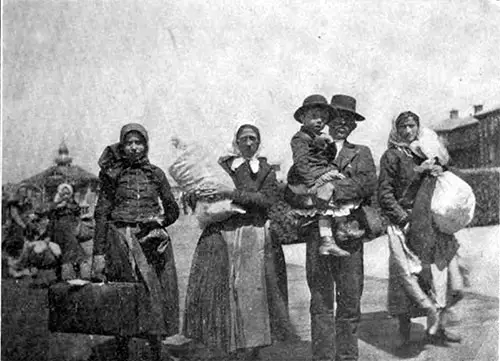
Immigrants at Ellis Island in 1913: Health, Stories, and Immigration Policies
Immigrants Going Through Ellis Island in 1913 offers an invaluable perspective for those studying immigration, particularly during the early 20th century.
For teachers, the article provides rich content for classroom discussions, particularly in U.S. history and immigration policy. Students studying sociology, history, or public health will find the examination of the immigrant experience, the medical inspection process, and the broader social implications to be deeply informative.
Genealogists can appreciate the details of the immigrant journey through Ellis Island and the personal stories embedded within, helping to understand their own family history.
For historians, the article is a powerful lens into the changing dynamics of U.S. immigration policy, social attitudes, and the challenges of managing immigration during a time of rapid industrialization and evolving societal norms.
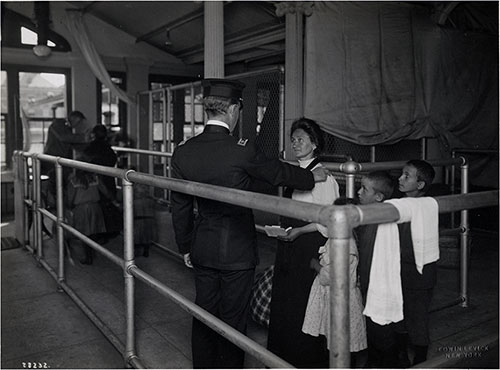
The Immigrant’s Journey: Processing at Ellis Island in 1913
This article provides a detailed, firsthand account of the experiences of immigrants, particularly steerage passengers, as they land at Ellis Island for processing. It offers a deep dive into the physical, emotional, and bureaucratic challenges immigrants faced upon arrival in the United States. For educators, students, genealogists, historians, and those studying immigration history, the article is a vital resource to understand the historical context and complexities of the immigration process during the early 20th century.
The narrative is particularly relevant for immigration studies as it explores the medical, legal, and social hurdles that immigrants encountered while being processed at Ellis Island, which was, at the time, the primary entry point for millions of immigrants. The description of the procedural steps taken to evaluate and detain or admit immigrants provides a clearer picture of the immigrant experience, illustrating both the human toll and the systemic operations of early 20th-century immigration law.
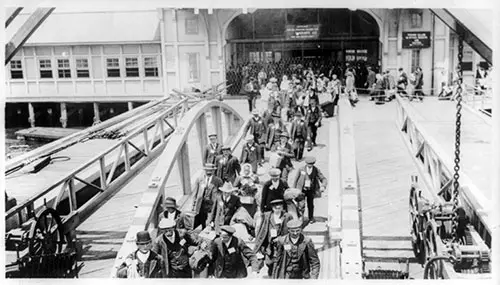
Guiding Immigrants: The Evolution of Support at Ellis Island in the Early 1900s
The article "Edison Sheds Light On The Immigrant" provides invaluable insight into the immigrant experience in the early 20th century, specifically at the point of entry at Ellis Island and the subsequent challenges faced by immigrants once they land in New York City. For teachers, students, genealogists, and historians studying immigration, the article serves as an essential resource for understanding the multifaceted nature of immigration in this era—from the chaotic and exploitative conditions at Battery Park to the significant reforms aimed at protecting immigrants from exploitation. The piece is particularly important for those exploring the early history of organized immigrant assistance in America and the role of civic organizations like the North American Civic League for Immigrants.
The narrative presents not just a factual recount of immigration statistics and processes, but also the social dynamics, including the exploitation of immigrants by unscrupulous guides and porters, providing a balanced view of both the hardships and the advancements in immigrant support systems. This context is vital for genealogists tracing immigrant ancestors or for those exploring the larger social and political impacts of immigration on early 20th-century American society.
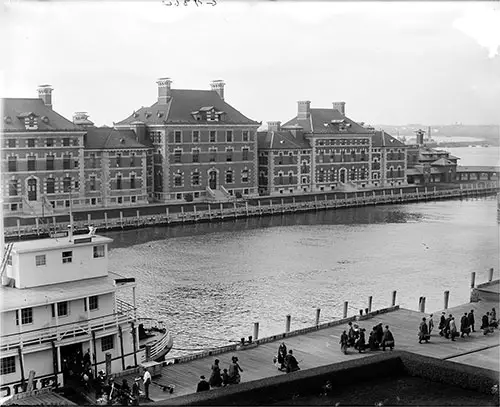
Protecting Immigrants at Ellis Island: The Battle Against Exploitation at the Barge Office (1914)
The article "Immigrant Safety and the Barge Office at Ellis Island (1914)" offers valuable insights into the immigrant experience during a critical period in U.S. immigration history. For teachers, students, genealogists, and historians studying the processes and challenges faced by immigrants, this piece provides a window into the systemic exploitation, safety concerns, and emerging protective measures surrounding the arrival of immigrants at Ellis Island and Battery Park.
It explores both the conditions faced by immigrants at the point of arrival and the often-dangerous situations they encountered once entering New York City. This content is particularly relevant for those examining the socio-economic factors that shaped immigration policy and practice, as well as the grassroots efforts to safeguard immigrants from exploitation.

A Thimble Theatre Performance on Ellis Island: Music as a Refuge for Immigrants (1916)
The article "A Performance By The Thimble Theatre On Ellis Island (1916)" offers significant insight into the role of cultural exchange in the immigrant experience, especially in the context of Ellis Island, the primary gateway for immigrants arriving in the United States.
For historians, genealogists, teachers, and students of immigration studies, this article serves as a valuable resource that not only explores the human side of immigration but also illustrates how immigrants, even in the midst of uncertainty and potential deportation, found moments of joy and solidarity through cultural events like performances by The Thimble Theatre.
The article highlights how such events served as a bridge to enhance the emotional and social well-being of immigrants detained on Ellis Island, providing a fascinating lens through which to examine the social dynamics of the early 20th-century immigrant experience.

Frederic C. Howe’s Reforms at Ellis Island: Humanizing the Immigrant Experience (1914-1916)
The article "Improvements At Ellis Island Inaugurated By Frederic C. Howe (1914-1916)" is a critical read for anyone studying the history of immigration to the United States, particularly through the lens of Ellis Island.
This article is particularly useful for teachers, students, historians, genealogists, and those interested in immigration policy as it highlights key reforms introduced by Frederic C. Howe during his tenure as Commissioner of Immigration at the Port of New York. Howe’s work at Ellis Island represents a turning point in how the United States managed immigration, emphasizing a more humane approach to the treatment of immigrants while addressing various systemic abuses in the process.

The Impact of Immigrants on America: A 1917 National Geographic Overview
The article "Our Foreign-Born Citizens" from the February 1917 edition of National Geographic Magazine is an invaluable resource for teachers, students, genealogists, historians, and anyone interested in U.S. immigration history.
It offers a comprehensive analysis of the demographic shifts due to immigration, the significant contributions immigrants have made to American society, and the evolving debates surrounding immigration policies during the early 20th century.
By examining the impact of immigration on the population and economy, this article provides a nuanced view of how immigrants shaped America, particularly in the context of industrial growth, labor, and cultural integration.
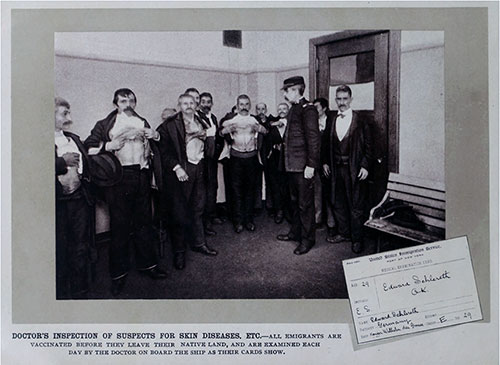
Ellis Island in 1918: The Inspection, Social, and Economic Realities of Immigrants
This detailed examination of the immigrant inspection process at Ellis Island in 1918 is an essential resource for teachers, students, genealogists, historians, and anyone researching the American immigration experience. The article provides a deep dive into the procedures and conditions faced by immigrants, offering valuable insights into the early 20th-century immigration system.
The complexities of immigrant experiences—ranging from physical and medical inspections to economic and social factors—are explored, offering a multifaceted view of immigration during this period.
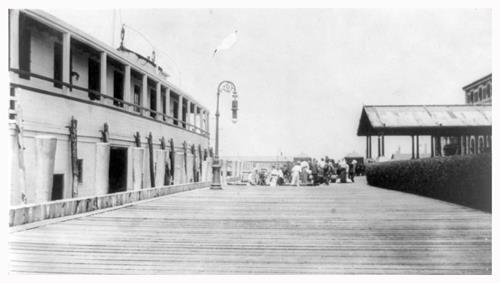
Ellis Island: Three Perspectives on Immigration and Military Mobilization in 1918
Ellis Island from Three Points of View is an intriguing piece that offers diverse perspectives on the Ellis Island experience, particularly during World War I. The article is essential for teachers, students, genealogists, historians, and others exploring the intersection of immigration, military service, and the role of women in wartime.
Through the eyes of three women involved in Army nursing duties, it also provides a unique perspective on Ellis Island’s military mobilization efforts and the human aspect of the immigration process during a critical time in history.
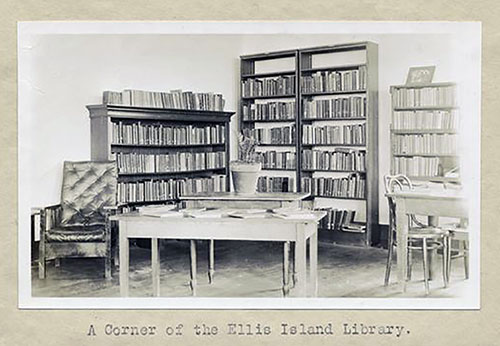
This article, The American Library Association's Work at Ellis Island, provides an insightful and fascinating look into an often-overlooked aspect of immigration history—the role of libraries in the lives of detained immigrants at Ellis Island.
For teachers, students, genealogists, and historians studying the cultural and social impact of immigration in the early 20th century, this work offers a unique perspective on how the American Library Association (ALA) contributed to the well-being of immigrants by providing educational resources and comfort during their detention. The inclusion of multilingual resources and stories of personal engagement further adds to its value for anyone researching immigrant experiences or cultural assimilation at Ellis Island.
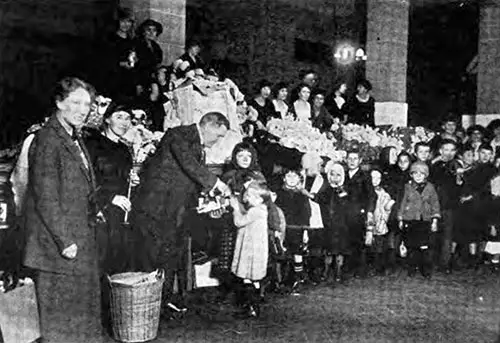
The New Regime at Ellis Island: Americanization and Immigrant Integration in 1920
The New Regime at Ellis Island (1920) offers a compelling look at a pivotal shift in the way immigrants were treated at Ellis Island during the early 20th century. For teachers, students, genealogists, and historians focused on immigration studies, this article provides essential insights into the evolution of immigration policy and the Americanization process.
The article highlights how the Americanization movement and reforms under Commissioner Wallace helped shape immigrant experiences. It serves as a valuable resource for understanding the transition from dehumanizing treatment to a more respectful and individual-centric approach that was aimed at transforming immigrants into engaged and responsible citizens of the United States.
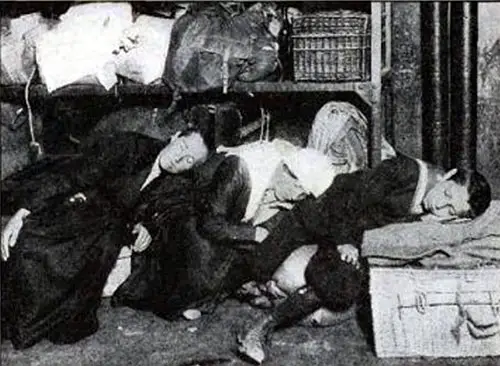
Ellis Island Overwhelmed: The Strain of Immigration in 1920
The article Ellis Island Filled to Limit with Immigrants (1920) is a vital resource for teachers, students, genealogists, historians, and anyone with an interest in the history of immigration in the United States. This piece provides an insightful look into the immigration surge of the early 20th century and the overburdened facilities at Ellis Island during the height of the wave.
The article offers a glimpse into the challenges faced by immigration authorities at the time and highlights the human cost of overcrowding, while also emphasizing the determination of officials to uphold immigration standards.
For historians and immigration scholars, the piece is a poignant reflection on the changing dynamics of immigration, showing how the rising tide of immigrants in the early 1920s taxed the already limited resources of the nation's primary immigration hub. For genealogists, it provides valuable context regarding the experiences of immigrants and the practical challenges of their journey through Ellis Island.
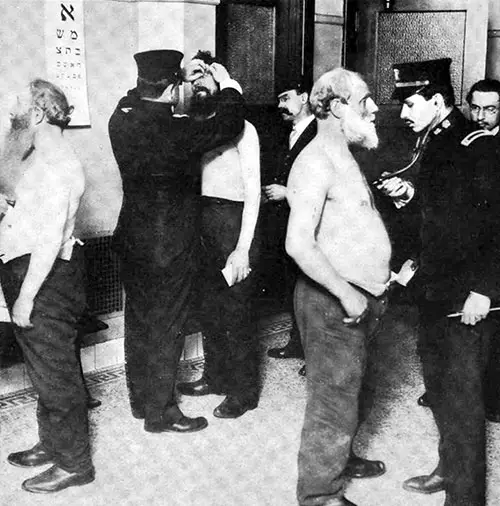
The Weeding of Immigrants: U.S. Immigration Policies in 1920
The article Uncle Sam Weeding Out Undesirable Immigrants (1920) offers a deep dive into the early 20th-century immigration policies and the screening process at Ellis Island. It holds significant value for teachers, students, historians, and genealogists interested in understanding the evolution of American immigration laws and their socio-political implications. The piece uses the metaphor of a garden to explore how the U.S. government, under Commissioner Frederick A. Wallis, approached the task of admitting immigrants—choosing those considered "fit" while rejecting those deemed "undesirable."
For historians and immigration researchers, the article illuminates the cultural mindset of the period, which was focused on both assimilation and exclusion. It presents the struggles and disappointments that immigrants faced, helping genealogists and family historians better understand the barriers their ancestors might have faced upon entering the U.S.
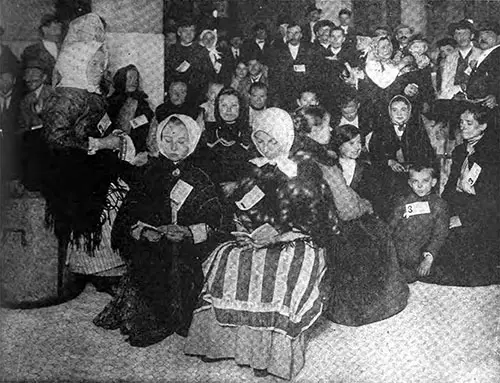
Where Bad Citizens Are Made: The Harsh Reality of Ellis Island’s Immigrant Experience (1921)
The article Where Bad Citizens Are Made (1921) offers a poignant, deeply critical examination of the immigration experience at Ellis Island, focusing on the harsh realities faced by immigrant women and children during the early 20th century. This article is especially relevant for teachers, students, genealogists, historians, and immigration scholars, as it provides a unique perspective on the intersection of gender, race, and immigration policy.
The piece critiques both the institutionalized mistreatment of immigrants and the social attitudes that underpinned immigration procedures at the time. Its rich content is ideal for those seeking to explore the human cost of immigration policies and the systemic challenges faced by immigrant families.
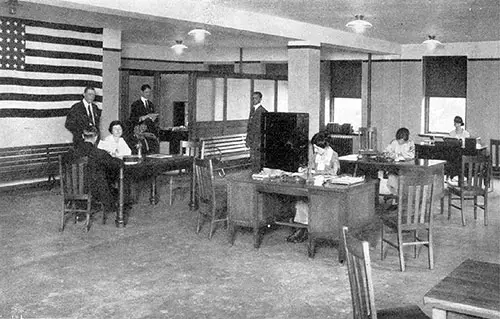
The article America's International Clearinghouse provides an insightful and detailed overview of the operations at Ellis Island during the peak of immigration in 1921, focusing on the critical role of the National Catholic Welfare Council (N.C.W.C.) in assisting immigrants.
This article is an invaluable resource for teachers, students, genealogists, historians, and immigration scholars, offering a deeper understanding of the immigration process at Ellis Island and the humanitarian efforts that aimed to alleviate some of the challenges faced by immigrants.
The article not only presents the logistical operations of immigration but also addresses the social, medical, and emotional dimensions of the immigrant experience at this iconic entry point to America.
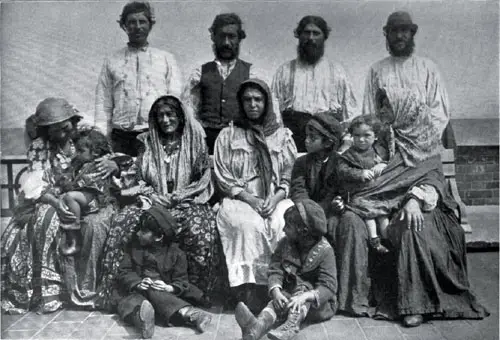
Urgent Reforms Needed: A 1921 Report on Immigration Conditions at Ellis Island
This article, Need for Reforms at Ellis Island Called Urgent, is a critical resource for those studying the history of immigration to the United States, particularly historians, students, genealogists, and educators. Published in 1921, it sheds light on the crucial role of Ellis Island during the early 20th century and serves as a historical document of the immigration process, revealing the challenges faced by immigrants and the inefficiencies within the U.S. immigration system at the time. The article presents an urgent call for reform and illustrates the complexity of managing the increasing number of immigrants entering the United States during a period of significant societal and political change. 📚
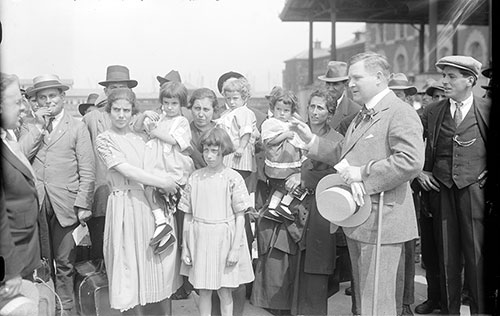
Navigating the Portals of America: Immigrant Challenges and Support at Post-War Ellis Island (1921)
The article At the Portals of America: Post-War Ellis Island, written by Edwin Carty Ranck in 1921, provides a vivid snapshot of the immigrant experience at Ellis Island after World War I. It is particularly valuable for immigration studies as it highlights the social dynamics, the challenges faced by immigrants, and the reforms being introduced to help them integrate into American society.
For genealogists, it serves as a poignant reminder of the personal experiences of immigrants arriving on U.S. shores, offering a glimpse into how they were welcomed and sometimes exploited. The story also speaks to historians examining the immigration process during the early 20th century, as it sheds light on both the institutional framework at Ellis Island and the individual struggles of immigrants during their transition to the United States.
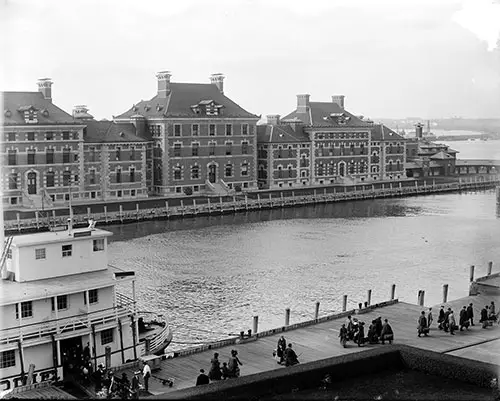
Revolutionizing Immigrant Reception at Ellis Island: Welfare Reforms and Their Impact (1922)
The article Conditions for Receiving Immigrants at Ellis Island Revolutionized (1922) highlights the significant reforms introduced to improve the conditions under which immigrants were received and detained at Ellis Island.
This article is crucial for immigration studies as it provides a detailed account of the systemic changes in the handling of immigrants, making it valuable for teachers, students, genealogists, and historians. The reforms described in the article shed light on the humanitarian and organizational shifts that took place at Ellis Island, giving a fresh perspective on the immigrant experience in the early 20th century.
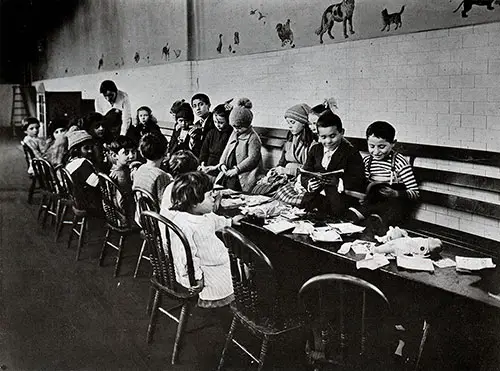
Ellis Island: The Human Side of Immigration in 1923
The article First-Hand Impressions of Ellis Island (1923) provides a unique and insightful view into the immigrant experience at Ellis Island in the early 20th century. This piece is invaluable for immigration studies, offering firsthand impressions and a human perspective on the immigrant process, particularly during the post-war era when the U.S. was experiencing significant waves of immigration.
Teachers, students, genealogists, and historians will find this article useful for understanding the historical context, humanization of immigration procedures, and the evolution of services at Ellis Island. The descriptions of the everyday experiences of immigrants serve as both historical documentation and a lens into the lives of those who passed through Ellis Island in search of a better life.
Ellis Island: The Hope and Tears of America's Immigrant Gateway
Ellis Island: Hope and Tears offers a comprehensive historical overview of one of the most significant landmarks in the immigrant experience in the United States. For teachers, students, genealogists, and historians, this article provides invaluable insight into the history of immigration, specifically the processing of immigrants at Ellis Island from its inception in 1892 to its closure in 1954.
The article's detailed accounts of both the difficulties and triumphs of the immigrants as they passed through Ellis Island give readers a balanced view of how the U.S. government responded to the waves of immigrants and the personal hardships endured by those arriving. This content is essential for exploring cultural assimilation, immigration policy, and the evolution of U.S. immigration practices over time.

The Origins of Ellis Island: Construction, Expansion, and the Immigrant Gateway (1890-1897)
The Story Behind the Opening of Ellis Island 1890-1897 offers crucial insights into the origins of one of the most iconic sites in American immigration history. This article is valuable for historians, genealogists, and students of U.S. immigration history. It covers the initial development of Ellis Island into an immigration station, its importance to the national immigration process, and its transformation from a military facility to the country’s most prominent immigration processing hub.
For educators, this piece provides a foundation for discussions about immigration infrastructure and the federalization of immigration laws, while genealogists can find useful context for tracing ancestors' journeys through Ellis Island.
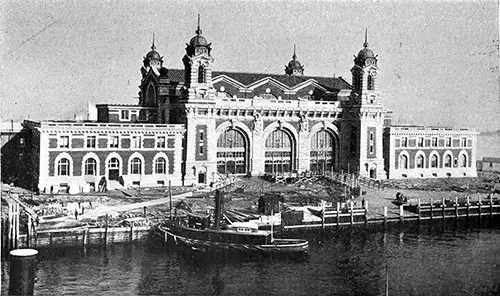
A Comprehensive History of America's Immigration Gateway (1890-1954)
Facts and Chronology About Ellis Island offers a deep dive into the history and significance of Ellis Island, providing both a chronological timeline of events and noteworthy statistics about the island's pivotal role in American immigration.
For teachers, this article serves as an excellent resource to help students grasp the operational history of Ellis Island and its place in the broader narrative of U.S. immigration. Genealogists can find value in the dates and facts related to immigrant processing, which may help them trace ancestors who passed through Ellis Island.
For historians, this document is an essential piece of understanding the evolution of immigration policy in the United States and how Ellis Island became a symbol of both hope and heartbreak for millions of immigrants.
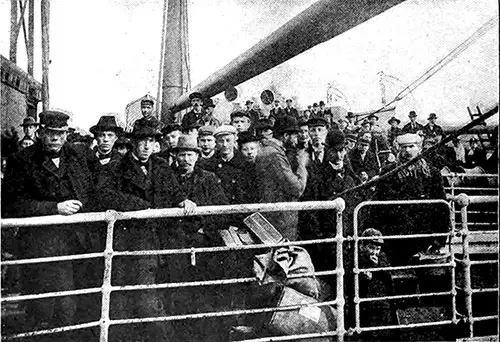
The Story Behind Ellis Island’s Immigrant Processing: Numbers, Challenges, and Policy Changes
How Many Immigrants Came Through Ellis Island? serves as a highly relevant resource for anyone interested in the detailed history of U.S. immigration.
For teachers, this article provides insight into the operational processes at Ellis Island, which is an essential part of U.S. immigration history. It presents complex data in an approachable manner, making it useful for students studying historical migration trends.
Genealogists will find the detailed estimates helpful for understanding the movement of immigrants through Ellis Island, which may assist them in tracing their ancestors’ paths. Historians will appreciate the article's nuanced look at the shifting patterns of immigration and the challenges in estimating exact figures.
End Notes
Note 1: In 1902, The Maltine Company issued an album of photographs, called Quarantine Sketches. It contains between thirty and forty engravings showing the care of immigrants at the New York quarantine station on Ellis Island, in all its phases from the arrival on shipboard to the departure by rail for the far west. It is altogether one of the most instructive booklets that has been published by the Maltine Company; and this is according it great praise, for the company is noted for the dissemination of useful material.

